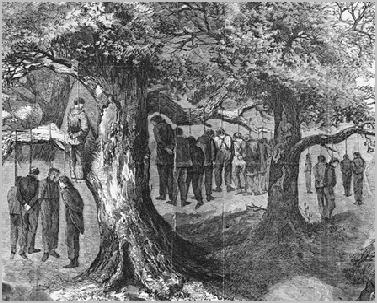

There were several freethinker communities across the USA including the Rationalist Society of St. Louis which was formed in 1848 and is still in existence today, making it the oldest autonomous Freethought organization in the United States. Their Naked Truth monument in St. Louis was dedicated to Praetorius, Schurtz and Danzer. The statue was moved from its original location in the wake of the anti-German sentiment of World War One. Also in Missouri, Hermann was founded in 1837, after being chosen by the German Settlement Society of Philadelphia for its resemblance to the Rhine Valley of Germany. It proved to be beneficial to farming, brewing and especially wine making. In the first few decades after its founding, it was also fertile ground for Free thought which was alive and well until 1854.
When the Civil War broke out, many Germans from Central Texas and the Texas Hill Country strenuously objected to being drafted into the Confederate army. The vast majority of German-Americans in the Texas Hill Country sided with Sam Houston in opposing secession and slavery, and some of the German farmers openly backed the Union government. This was taken as a sign of treason and rebellion by Confederate authorities who sent in troops in the spring of 1862.
The local residents of Comfort, Texas had formed the Union Loyal League to protect themselves from Indian and outlaw attacks, and this worried the Confederacy who regarded the group as a potential threat. Martial law was declared, and the Texas Rangers ordered all males over 16 years old to take an oath of allegiance to the Confederacy or leave the state. Forced to choose between their hard-won farms and homes or violating their consciences, many refused to take the oath. As a result, their farms and homes were burned and some of the local residents, about 150 by some accounts, were lynched.
After the violent confrontation between Confederate soldiers and civilians broke out in Kinney County on August 10, 1862, many German Texans decided to high-tail it to Mexico, and a party of 61 German Texans fleeing from the Hill Country counties were overtaken by Texas Confederate cavalrymen on the Nueces River. Shots were fired and 36 German Texans were killed as a result, some being executed upon capture. The bodies of these farmers and those killed on the Nueces River were left unburied until the end of the war. Three years later the remains were returned and buried in a mass grave in Comfort. Other Germans from Central Texas managed to complete their journey to Mexico City under the leadership of Paul Machemehl of Austin County.
The Treue der Union memorial was erected in 1866 in honor of nineteen Germans settlers killed on August 10, 1862 in the Battle at Nueces. Their remains are buried on the East side of the monument. It also honors the nine additional Germans taken prisoner or murdered after the battle as well as seven more killed at Rio Grande, October 18, 1862. The Treue der Union or True to the Union Monument is inscribed with the name of the men who were killed. Outside of National Cemeteries, this remains the only monument to the Union erected in a state south of the Mason-Dixon line. This monument, listed in the National Register of Historic Places, is also noteworthy for another unusual feature. In 1991, the Treue der Union Monument became one of only five sites in the nation where the flag is allowed to be flown at half staff at all times. The flag flown here is the thirty-six star American flag, the one flown at the dedication of the monument long ago.
In 1990, the US census revealed that 1,175,888 Texans claimed pure and 1,775,838 partial German ancestry, for a total of 2,951,726, or 17½ percent of the total population.